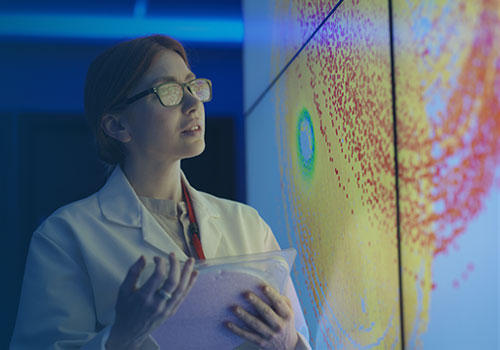< Back to Optum Life Sciences Home Page
Well before the pandemic, life sciences leaders were using real-world data across all parts of the product lifecycle — from discovery and development through approval, post-approval value messaging support and longer-term patient monitoring.
Today’s research and development pipelines will demand an even more holistic and expansive use of real-world data. With so many precision therapies in development, life sciences leaders must generate evidence that doesn’t just show safety and efficacy but also helps payers, providers and patients make complex decisions about treatment planning, coverage and value.
This is true not only for cell and gene therapies treating rare diseases but also for next-gen therapies treating more common conditions like migraines, heart disease or autoimmune disorders.
Life sciences leaders can take a variety of strategic approaches to harness the full potential of real-world data in ways that drive meaningful conversations about evidence, value and access.
Thinking differently about access, value and contracting
Paying for value is not a new concept. We’ve seen a wide variety of innovation here, but mostly in the provider sphere. The coming wave of high-cost precision therapies is shining a spotlight on the need for value-based payment models that can work for drugs and biologics as well.
To bring these next-gen precision therapies to market, we’re all going to need to think differently about value-based contracts — and the real-world data required to support them.
Recently, I had the opportunity to discuss these new ways of thinking with Solomon Banjo, managing director of the health care ecosystem research team at Advisory Board, Erin Satterwhite, president and general manager of Optum Frontier Therapies, and Erik Schindler, director of emerging therapeutics and outcomes-based contracting at UnitedHealthcare.
Below are some key takeaways from my conversation with Solomon, Erin and Erik.
- Old habits die hard. New value-based payment models introduce variability and uncertainty with associated levels of risk that can be hard for payers and life sciences companies to tolerate. As you watch this session, listen for Erik’s thoughts on the role that trust and partnership play in acknowledging these risks and developing more innovative approaches to payment.
- Value is in the eye of the stakeholder. Solomon illuminated the challenges of finding common ground when different parties don’t even align on critical definitions of meaningful outcomes and metrics.
- Payers and employers are no longer comfortable with the status quo. Large upfront reimbursements for ultra-high-cost durable treatments that may not work as fully intended for every patient don’t align payment with value. The pressure to innovate on payment models may be starting with cell and gene therapies, but it won’t end there.
- Just get started. Erin emphasized the need to prioritize “good enough” over perfection to gain more experience with value-based contracts in the market. She encouraged leaders to start small, stay agile and adapt based on each experience.
Watch the webcast, "Prepare for Impact: Supporting the Coming Wave of Precision Therapies."
Rethinking your strategy
Successful value-based contracts require a lot of advanced planning and collaboration. Lisa Carman, Optum vice president of HEOR and value-based contracting, sat down with Joanne Sellner, senior advisor for National Accounts at Eli Lilly, and Emily Chee, general manager at Novartis Gene Therapies, to talk about how organizations can meet these needs.
Each of them offers insightful details about what it takes to put value-based contracts in place. They highlight the preparation that goes into all these agreements and note that plans for evidence requirements, data collection processes and partnership strategies must begin well before launch.
Watch the conversation, “Better Together: Product Development and Launch Strategy in the Age of Precision Medicine.”
Unlocking your own outcomes-based contract capabilities
Value-based contracts for precision therapies have the potential to be transformative for payers, pharmaceutical companies and patients. But for these kinds of contracts to be effective, payers need to know how these therapies will work in the real world. And they need to know how to connect these therapies to the patients likely to benefit the most.
Allison Combs, Optum senior director of product strategy in the payer market, spoke with Mari-Pat Kalla, Optum senior director of product, and Erin Hubert, Optum director of value-based contracting, for insights into these arrangements. They discussed our enablement platform and the solutions we’re building with data experts from the payer and value-based contract areas of our business to help connect manufacturers and payers as they move toward value-based arrangements.
Watch the discussion, “Enabling the Next Generation of Outcomes-Based Contracts.”
Building the right data foundation
Lou Brooks, Optum senior vice president of real-world data and analytics, and Brian Solow, MD, chief medical officer of Optum Life Sciences, walked us through the competencies necessary for life sciences companies to get the most out of their real-world data investments.
The two leaders discussed their thoughts on the importance of establishing a centralized data office, maintaining clear data governance programs and ensuring sufficient data science capabilities in-house.
Watch the dialogue, “Curating and Scaling Real-World Data to Support the Drive to Targeted Therapies.”
Applying clinicogenomics across the product lifecycle
As genomic data becomes more readily available, it has the potential to impact all parts of the product lifecycle, especially when it’s combined with phenotypic data to generate robust clinicogenomic datasets.
This is true not only for drugs targeting rare diseases or genetic disorders, but also for the growing number of precision therapies tied to specific biomarkers.
Optum Vice President of real-world evidence and genomics, Ashley Brenton, PhD, was joined by physicians from UnitedHealth Group and Merck to talk through ways life sciences companies can best harness the progress in genomics to make real changes in precision medicine. They also shared some of their predictions about the future of disease-specific treatments and diagnostic innovations.
Watch the recap, “Empowering Precision Drug Development.”
Using technology to improve the research experience
We know real-world data adds depth to our understanding of clinical costs, utilization and outcomes. But, combined with the right technology, real-world data can also enhance clinical research efficiencies.
Peter Payne and Tracy Ohrt, both with the Optum® Digital Research Network, walk through a fully digitized observational study using electronic informed consent, real-world data and electronic patient-reported outcomes.
Their conversation raises a lot of great questions about how old habits may continue to hinder our ability to recruit patients faster and alleviate clinical investigators’ workload burdens.
It’s time to consider how real-world data can help us break out of old habits and reimagine some of our clinical trial processes through reducing costs, alleviating study site burden and getting you to your trial goals quicker.
Watch the exchange, “Reducing Roadblocks: Clinical Studies in the Digital Age.”
Optum role as a connector
The rapidly proliferation of real-world data sources — and compelling real-world evidence use cases — make it more important than ever for life sciences companies to work with trusted, connected partners who understand the needs of stakeholders across the health care ecosystem.
Here at Optum Life Sciences, we want to be that trusted connector. How can our real-world data, experts and cross-industry insights help you connect the dots to improve patient care? Let’s keep the conversation going.
Sign up for the Evidence in Action newsletter
Get a closer look at how evidence is advancing life sciences.
Related Content

"Health plan executives look forward" study and more



